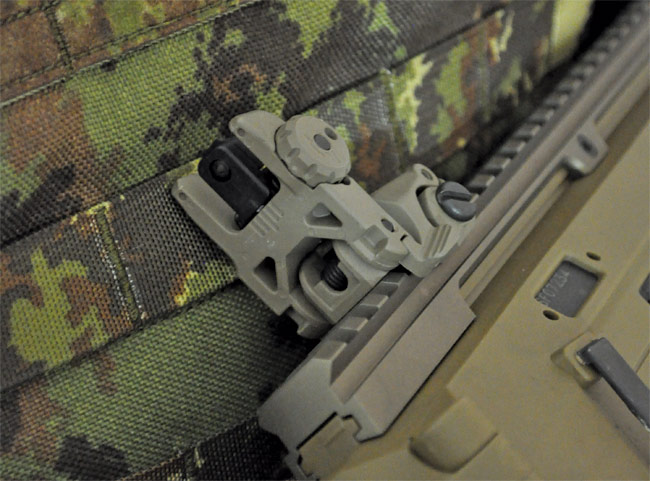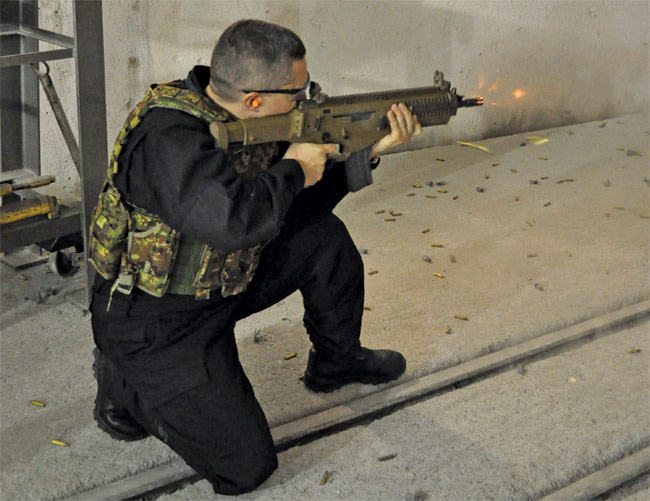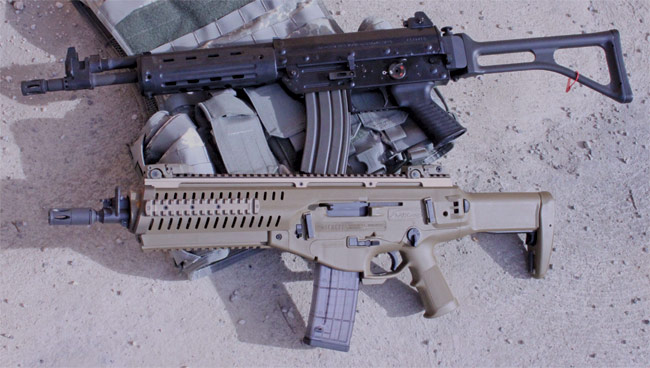It is very recent the release of the ARX160 infantry version in 7.62 x 39, done during the SHOT Show 2012.
But the ARX160SF too can be easily converted to the Kalashnikov caliber, using a conversion kit that uses only four components: barrel, bolt group, lower receiver and original AK47 mags.
Ing. Galluzzi transformed the ARX160SF in 5.56 NATO we were about to test to an assault rifle able to shoot Kalashnikov ammo and to use Kalashnikov mags in less than 2 minutes.
The barrel in the Russian caliber is 16-inches long, and the only difference from the 5.56 NATO, aside the obvious dimensions of the bore and chamber, is the hole diameter of the gas port.
The lower receiver has some slight differences from the 5.56 version: there are no mag release buttons on the side and no multifunctional button at the bottom of the trigger guard. This last item has been replaced with a central mag release lever that engages and locks in position the AK47 magazine.
Since the multifunctional button has been removed, the ARX160 bolt does not remain open after the last round is fired, as in the Russian assault rifle.
The bolt group, instead, retains the selectable ejection port and the reversible charging handle features: the bolt head keeps its two extractor system, but the dimensions, of course, allow the use of the M43 Russian ammo.
But the surprises did not end there: Ing. Galluzzi showed us the ARX160SF suppressed version, currently in only the 5.56 NATO caliber. The basic conversion kit for the suppressed carbine has two items: the barrel with the integral suppressor and a cover for the ejection port.
The sound suppressor, similar to the snap on version by Brugger & Thomet on Beretta specifications, is permanently attached to the barrel and fully tuned for the weapon, giving a superior overall performance if compared to the snap on version.
Since the use of the suppressor generates a counter pressure in the barrel and the emission of a quite consistent cloud of gas and powder combustion residue from the ejection ports when the bolt opens, before using the silenced weapon a cover must be put on the unused ejection port, in order to avoid the dust to be projected on the shooter’s face.
The cover is a piece of polymer snap-on mounted to the ARX160 using the two sling mounts located near the ejection ports and the brass deflector.
In the silenced configuration the Beretta assault rifle can use both ordinary and subsoninc 5.56 rounds. In the first case the suppressor will work as a sound moderator, attenuating the blast sound and making it difficult for the enemy to detect the exact direction from where a soldier armed with a suppressed ARX160 is shooting. Of course the automatic bolt cycling of the weapon will be preserved. With subsonic rounds, the sound suppressor will work as a real silencer, but with the disadvantage of disabling the automatic bolt cycling and forcing the shooter to manually load each round operating the charging handle each time. Since the dimensions of the ARX160 charging handle are quite small and reloading is supposed to happen a number of times, Beretta provides a rubber insert that can be snap-on mounted on the charging handle, increasing the dimensions and making the manual reload operation much simpler.
Along the ARX160SF we used during the test (with the 12-inch barrel) we found a semi-transparent plastic magazine, STANAG 4179 compatible, inserted. We heard, three years ago, that Beretta was studying to replace the steel AR70/90 mags with lighter semi-transparent mags of equivalent capacity. But we were told that the one we found was still a prototype and thus we preferred to use the steel type, since those are the ones used in operations in Afghanistan by Italian armed forces that received the ARX160SF for advanced field testing.
A good number of steel 30-round magazines with Fiocchi SS109 cartridges were filled though the range test was started with blank, basic manipulation of the rifle to get some familiarity and confidence with it.
And here came the first surprise: the ARX160SF has been designed for tough guys. All the commands, safety/selector lever, multifunctional button, even the force needed to handle the charging handle, requires more force and a more sharp action as compared to the infantry version. The rotation angle of the safety/selector lever has been kept at 82 degrees, but the strength required to switch the selector into each of the three positions has considerably increased, allowing the operator to have more control if he switched the weapon to semi-auto or full auto fire in situations of strong stress. We were told that this feature was an explicit requirement by Italian SF operators. Additionally, to operate the hold open button to hold the bolt or to make it close when a fresh magazine was inserted required extra exertion. On the top Picatinny rail we found mounted a set of Magpul MBUS Gen 2 iron sights.
The first part of the test and evaluation began by firing a 30-round magazine in semiautomatic only, in a standing position, at a target 50 meters in the distance.
We found the ARX160SF’s slight modification of the length affected the reaction to recoil of the carbine in comparison with the infantry version: being the “SF” carbine a bit more jumpy and requiring the shooter to have a better the grip on the weapon.
The new button to adjust the buttstock length (both testers were wearing body armour and had different body structure) worked much better than the one present in the infantry version: adjusting takes really just a few seconds.

The grip of the buttstock on the shoulder, even with body armour, was excellent, and if correctly handled and aimed, the carbine tends to be very stable in semi-auto, allowing very fast double taps.
The trigger pull was progressive, with good feedback when the hammer was released and little trigger over-travel after each shot. The large surface of the trigger, engaged by the tip of the shooter’s finger, did not help a lot in semi-auto.
For the second step of the range test we switched to full auto. The aim was to check how controllable the weapon was when shooting and if it was possible with little effort and training to have controlled bursts of three or even two rounds.
In this case the trigger design in conjunction with the relatively low fire rate helped a lot in obtaining short bursts of three rounds quite easily.
While the 12-inch barreled ARX160SF muzzle did not show any sign to rise at each burst, it had the tendency to move a little toward the right, being a bit different from the infantry counterpart. It’s something that a better confidence with this weapon and more training could easily solve as it’s made for soldiers that can shoot up to 500 rounds a day when in intensive training.
The more that we got familiar with the ARX160SF, the more the control got easier. Further, the overall design of the weapon and the ergonomics greatly helped the shooter to realign sights fast and well for the next shooting action.
The Beretta SF carbine was tested in full auto shooting in all the three classical positions (standing, kneeling and prone) and from the hip.
As a shooting platform, despite the first impression, the ARX160SF, and ARX160 family in general, is really stable even allowing long bursts of more than five rounds. Testers were always able to control the direction of fire quite efficiently, this due to the design that optimized force vectors, moving mass balance and weight distribution.
In the prone position the ARX160SF simply didn’t move at all, despite all the attempts we did to find the limit of this carbine and sporadically unleashing even 10 rounds bursts.
The smoke of the last shooting sequence was not yet cleared in the air and the ARX160SF was still hot when we started the last and most important part of our test in full auto: shooting six mags in full auto, 180 rounds, in what can be called a “break contact” simulation. Aiming at the same point of the bullet trap, we shot five-round bursts with one second of pause to execute a visual scan and then again delivering fire with another five-round burst. When a magazine was completely emptied in this way, the testers performed a tactical magazine change and continued shooting until the test had been completed.
A little smoke started to go through the ventilation holes in the front handguard after the first 90 rounds, and even with gloves the heat was clearly perceptible, but it was never so intense as to force the testers to change their grip on the handguard or to stop.
After the last magazine was emptied, smoke and heat had increased, but still the ARX160SF was operational and we were able to handle it without problem, registering no malfunctions during the whole test.
Precision testing was performed by mounting a Steiner 1-4 x 30 riflescope on the ARX160SF. The carbine was shot using a rest under the front handguard. The target was the one used by Beretta for factory test and to zero their firearms at 80 meters, the longest distance allowed by the tunnel and the illumination.
30 rounds were fired, with the optic roughly zeroed, but the purpose was to get the tightest grouping on the target in those conditions and always using the standard SS109 military round. Keeping in mind that the ARX160SF is an assault carbine made for endurance and reliability while in combat, the average shot pattern we got for any number of rounds during the precision test was a constant 2.5 MOA grouping.
Conclusions
Approximately 400 rounds were shot with the ARX160SF in various positions during the range test and in almost all the conditions allowed in an indoor range.
The ARX160SF has shown to be a very stable shooting platform and the Beretta design already offered the flexibility that had been promised when the new assault rifle was presented to the Italian Armed Forces in 2009.
Beretta, in that occasion, announced that the ARX160 family would be able to shoot not only the 5.56 NATO, but at least other two calibers: 7.62 x 39 and 6.8 SPC. Now the version in AK47 caliber (and the related conversion kit) has seen the light, with an eye to the Spec Ops community, but also to the former Warsaw Pact armed forces markets and all the related network of countries that already use the Russian cartridge. We can only wonder when the 6.8 SPC version will be released, if it will be a complete firearm or just a simple conversion kit.
In any case, the impression that the Beretta ARX160SF gave us is that the weapon is ready for the battlefield but only time will tell if it really is a star born in the Spec Ops weapon panoply.











